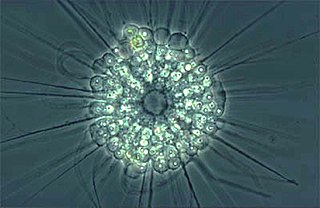
The actinophryids are an order of heliozoa, a polyphyletic array of stramenopiles, having a close relationship with pedinellids and Ciliophrys. They are common in fresh water and occasionally found in marine and soil habitats. Actinophryids are unicellular and roughly spherical in shape, with many axopodia that radiate outward from the cell body. Axopodia are a type of pseudopodia that are supported by hundreds of microtubules arranged in interlocking spirals and forming a needle-like internal structure or axoneme. Small granules, extrusomes, that lie under the membrane of the body and axopodia capture flagellates, ciliates and small metazoa that make contact with the arms.

A flagellate is a cell or organism with one or more whip-like appendages called flagella. The word flagellate also describes a particular construction characteristic of many prokaryotes and eukaryotes and their means of motion. The term presently does not imply any specific relationship or classification of the organisms that possess flagella. However, the term "flagellate" is included in other terms which are more formally characterized.
The gymnosphaerids are a small group of heliozoan protists found in marine environments. They tend to be roughly spherical with radially directed axopods, supported by microtubules in a triangular-hexagonal array arising from an amorphous central granule.

The centrohelids or centroheliozoa are a large group of heliozoan protists. They include both mobile and sessile forms, found in freshwater and marine environments, especially at some depth.

The Radiolaria, also called Radiozoa, are protozoa of diameter 0.1–0.2 mm that produce intricate mineral skeletons, typically with a central capsule dividing the cell into the inner and outer portions of endoplasm and ectoplasm. The elaborate mineral skeleton is usually made of silica. They are found as zooplankton throughout the global ocean. As zooplankton, radiolarians are primarily heterotrophic, but many have photosynthetic endosymbionts and are, therefore, considered mixotrophs. The skeletal remains of some types of radiolarians make up a large part of the cover of the ocean floor as siliceous ooze. Due to their rapid change as species and intricate skeletons, radiolarians represent an important diagnostic fossil found from the Cambrian onwards.

The Heliomonadida are a small group of heliozoan amoeboids that are unusual in possessing flagella throughout their life cycle.

Chromista is a proposed but polyphyletic biological kingdom consisting of single-celled and multicellular eukaryotic species that share similar features in their photosynthetic organelles (plastids). It includes all eukaryotes whose plastids contain chlorophyll c and are surrounded by four membranes. If the ancestor already possessed chloroplasts derived by endosymbiosis from red algae, all non-photosynthetic Chromista have secondarily lost the ability to photosynthesise. Its members might have arisen independently as separate evolutionary groups from the last eukaryotic common ancestor.

Cercozoa is a phylum of diverse single-celled eukaryotes. They lack shared morphological characteristics at the microscopic level, and are instead united by molecular phylogenies of rRNA and actin or polyubiquitin. They were the first major eukaryotic group to be recognized mainly through molecular phylogenies. They are the natural predators of many species of bacteria. They are closely related to the phylum Retaria, comprising amoeboids that usually have complex shells, and together form a supergroup called Rhizaria.

The Rhizaria are a diverse and species-rich supergroup of mostly unicellular eukaryotes. Except for the Chlorarachniophytes and three species in the genus Paulinella in the phylum Cercozoa, they are all non-photosynthethic, but many foraminifera and radiolaria have a symbiotic relationship with unicellular algae. A multicellular form, Guttulinopsis vulgaris, a cellular slime mold, has been described. This group was used by Cavalier-Smith in 2002, although the term "Rhizaria" had been long used for clades within the currently recognized taxon. Being described mainly from rDNA sequences, they vary considerably in form, having no clear morphological distinctive characters (synapomorphies), but for the most part they are amoeboids with filose, reticulose, or microtubule-supported pseudopods. In the absence of an apomorphy, the group is ill-defined, and its composition has been very fluid. Some Rhizaria possess mineral exoskeletons, which are in different clades within Rhizaria made out of opal, celestite, or calcite. Certain species can attain sizes of more than a centimeter with some species being able to form cylindrical colonies approximately 1 cm in diameter and greater than 1 m in length. They feed by capturing and engulfing prey with the extensions of their pseudopodia; forms that are symbiotic with unicellular algae contribute significantly to the total primary production of the ocean.
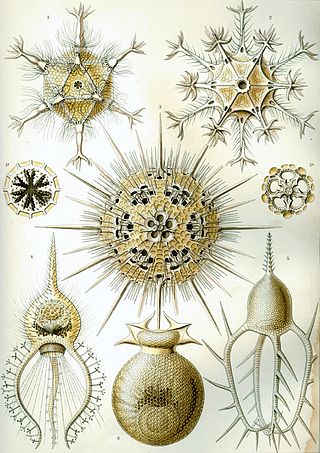
Phaeodarea, or Phaeodaria, is a group of amoeboid cercozoan organisms. They are traditionally considered radiolarians, but in molecular trees do not appear to be close relatives of the other groups, and are instead placed among the Cercozoa. They are distinguished by the structure of their central capsule and by the presence of a phaeodium, an aggregate of waste particles within the cell.
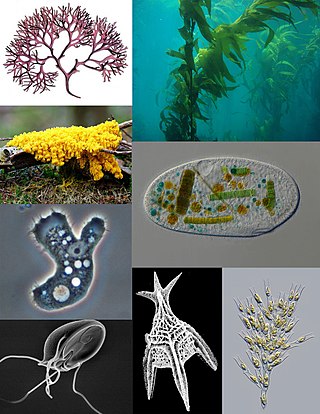
A protist or protoctist is any eukaryotic organism that is not an animal, plant, or fungus. Protists do not form a natural group, or clade, but an artificial grouping of several independent clades that evolved from the last eukaryotic common ancestor.

Protozoa are a polyphyletic group of single-celled eukaryotes, either free-living or parasitic, that feed on organic matter such as other microorganisms or organic debris. Historically, protozoans were regarded as "one-celled animals".
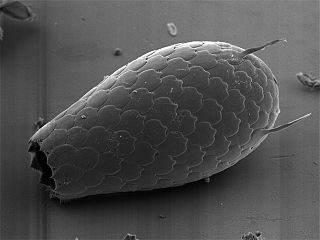
Imbricatea is a class of Rhizaria characterised by silica scales. It is sometimes described as "Imbricatea/Silicofilosea", due to the similarity of those two groupings. Imbricatea is divided into the orders Euglyphida and Thaumatomonadida.
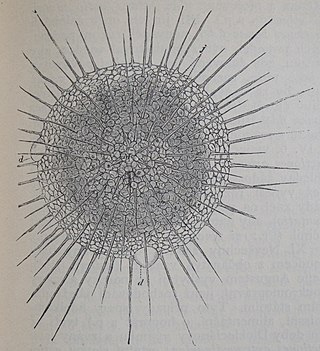
Actinosphaerium is a genus of heliozoa, amoeboid unicellular organisms with many axopodial filaments that radiate out of their cell. It is classified within the monotypic family Actinosphaeriidae and suborder Actinosphaerina. Species of Actinophrys are distinguished by their large number of nuclei in each cell. Their axopodia sometimes terminate on the surface of nuclei. Vacuoles are abundant in the periphery of the cytoplasm.
Pinaciophora is an amoeboid genus of Heliozoa of uncertain affinity, previously classified as Rhizaria.

An amoeba, often called an amoeboid, is a type of cell or unicellular organism with the ability to alter its shape, primarily by extending and retracting pseudopods. Amoebae do not form a single taxonomic group; instead, they are found in every major lineage of eukaryotic organisms. Amoeboid cells occur not only among the protozoa, but also in fungi, algae, and animals.
The initial version of a classification system of life by British zoologist Thomas Cavalier-Smith appeared in 1978. This initial system continued to be modified in subsequent versions that were published until he died in 2021. As with classifications of others, such as Carl Linnaeus, Ernst Haeckel, Robert Whittaker, and Carl Woese, Cavalier-Smith's classification attempts to incorporate the latest developments in taxonomy., Cavalier-Smith used his classifications to convey his opinions about the evolutionary relationships among various organisms, principally microbial. His classifications complemented his ideas communicated in scientific publications, talks, and diagrams. Different iterations might have a wider or narrow scope, include different groupings, provide greater or lesser detail, and place groups in different arrangements as his thinking changed. His classifications has been a major influence in the modern taxonomy, particularly of protists.

Ultrastructural identity is a concept in biology. It asserts that evolutionary lineages of eukaryotes in general and protists in particular can be distinguished by complements and arrangements of cellular organelles. These ultrastructural components can be visualized by electron microscopy.
Tetrahelia is a genus of four-ciliated protists belonging to the Endohelea, a group of heterotrophic eukaryotes previously considered heliozoa. It is the only genus in the family Tetraheliidae and order Axomonadida. It is a monotypic genus, containing the sole species Tetrahelia pterbica, previously classified as Tetradimorpha.
Heliorapha is a genus of heliozoan protists, amoeboid eukaryotes with stiff axopodia radiating from their cells. It contains one species, Heliorapha azurina. It is classified within a monotypic family Helioraphidae inside the actinophryids, a group of heliozoa that belong to the Ochrophyta along with other protists such as diatoms and brown algae.



















